#jose rizal: historical figure
Text
His name's Jose RIZZal with how many ladies fell for him.
#it was like at least 7#shitpost#joke#jose rizal#cringe joke#cringe#hehe#philippine history#history#national hero#historical figure#filipino#philippines#pinoy
3 notes
·
View notes
Text
Kabesang Tales - Isang Rap en Rol Musical
A Filipino Musical that hasn't left my mind since the mid 2010s

Poster for Kabesang Tales posted by Palakat Batangas City via Facebook
Although the Philippines is known for its many talented singers which include many that had crossed over to Broadway such as Lea Salonga, and Rachelle Ann Go, alongside many other Filipino-American talents like Conrad Ricamora, Arielle Jacobs, George Salazar, and Darren Criss just to name a few, the musical scene in the Philippines itself isn't as popular nor as successful in the country as it really should be.
Even with Filipino-majority musicals in states like the controversial Broadway musical "Here Lies Love" which narrates the life story of Imelda Marcos, one of the most controversial figures in Filipino politics and history today, and with Filipino stars often taking in lead or secondary roles in major productions, the musical boom of the 2010s did not come with a boom for the musical industry in the local level compared to the sudden popularity of American musicals like Hamilton, Heathers, Dear Evan Hansen, or Be More Chill to name a few.
The very few musicals that did garner the spotlight did not receive the same notoriety of these foreign productions save for one of the few musical movies to have gotten major media acclaim Loy Arcena's Ang Larawan (2017) (en. The Portrait) based on the 1997 play of the same name by National Artist Nick Joaquin which became a media frenzy as being maybe one of the few if not the only original movie not based on major series or created by a large production company to be released that year for the Metro Manila Film Festival. One of the things that had skyrocketed it to media attention was the fact that most theaters did not screen it and it was only shown in very few cinemas, but that's a story for another time.
Despite the time and devotion Filipino musical fans may have for theatre, rarely do Filipino made and produced musicals ever enter the pop culture zeitgeist due to many factors like the lack of advertising, accessibility issues, and honestly the lack of cast recordings. Out of the many throughout the 2010s, one of the few I was able to watch that I still think about at times is Ricky Lee's very own rap and rock musical Kabesang Tales.
Background
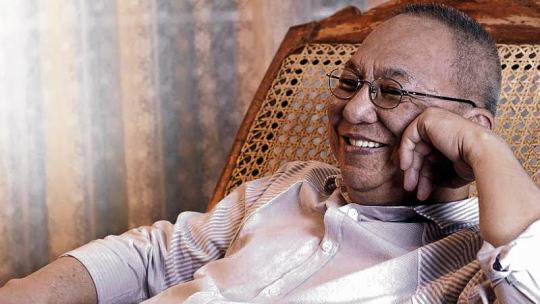
Photo of Ricky Lee, the writer of Kabesang Tales the Musical via Inquirer
Kabesang Tales - Isang Rap en Rol Musical) (en. Captain Tales - A Rap n' Roll Musical) is a rap and rock musical first performed in the year 2015 and was written by renowned Filipino writer and National Artist Ricky Lee. The musical was directed by Alejandro "Bong" Ramos, with music by Jeffrey Hernandez and Alfredo Ongleo, and produced by Red Lantern Production (Inquirer, 2015).

Photo of John Arcilla, the lead actor for Kabesang Tales the Musical via Inquirer
The musical stars John Arcilla as the titular character Telesforo Juan "Kabesang Tales" De Dios, famously known for his breakout role as Hen. Anotnio Luna in the historical film Heneral Luna released the same year as the musical, alongside other talents such as Dio Marco as Karyo, Kevin Posadas as Tano de Dios, Alecx Lorica as Juli De Dios among many other talented actors (Inquirer, 2015).

A cover of one of the book's translations posted by twitter user El Filibusterismo (@/joseriz15155899) via X/Twitter
The play is based on Jose Rizal's El Filibusterismo (en. The Filibuster) and more specifically, the character of Kabesang Tales, the head of his barangay (a sort of Filipino village) and father of Basilio's main love interest Juli, who had turned into a guerilla bandit after his family and life were ruined by the Spanish friars. He becomes the feared Matanglawin (en. Hawkeye) who terrorizes the countryside. He plays a minor but important role in the books, being the father of one of the main secondary characters as well as being one of the main allies of the primary characters as they tried to start a revolution in the country.
The play primarily focuses on his perspective throughout the whole book with some scenes focusing more on the main protagonists Simoun and Basilio as well as his daughter Juli.
Performances and Releases
The musical had limited performances throughout some parts of the CALABARZON Region or Region IV-A, with some select performances in Metro Manila as well as some other provinces like in Mindoro, sometime during the years 2015-2017 with some being done in local cultural centers and schools throughout the region with very limited promotion outside of news stories.
The only promotional material I could really find are some posts on Facebook and a trailer in the Red Lantern Production's YouTube channel which could be seen here:
youtube
Trailer uploaded by Red Lantern Production via YouTube
There are no original cast recordings that I could find of any of the songs and the only material that I could find besides this are uploads on YouTube of scattered scenes from different parts of the play:
youtube
Full Playlist uploaded by YouTube channel pheejaypi here
I was also able to find a collection of clips of Karyo, a character possibly named after Karyo from Mga Ibong Madaragit which is a continuation novel of the El Filibusterismo written by Amado Hernandez, played by Terrence Guillermo.
youtube
Video uploaded by YouTube channel pinoy music maestro here
I remember some time in the 2010s seeing uploads of members of the cast singing in interviews I believe but I could no longer find any of these videos.
As of now, it is unknown if the production will ever come back with the last post on the Facebook page having been in 2021 with a post prior to posted on July 2019 calling for auditions in August 2019, possibly hinting that there was a planned 2020 tour for the musical before the pandemic hit.

Photo of the audition announcement posted on Facebook
The Plot (mostly from memory)
As there's barely any material of the live musical, I'll do my best to recollect what I could remember with the aide of the actual books to guide me. Of course, spoilers for Rizal's books Noli Me Tangere and El Filibusterismo if you haven't read them.
The plot follows the events of El Filibusterismo but mainly from the perspective of the titular character Kabesang Tales. It begins with an extremely happy and optimistic scene with him, his family, and barangay as well as the visit of Basilio, Tales's daughter's lover to their house. I remember that there was an extremely cheesy song here between the two that a lot of people squealed over.
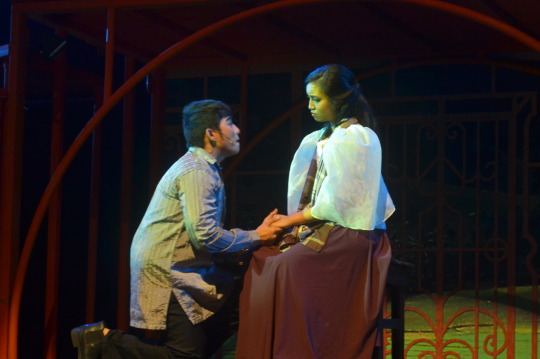
Photo of the mentioned musical number between Basilio and Juli posted by Jayson Pascua
The perspective switches over to Basilio and his visit to his mother's grave where he is shocked to see a man there who is revealed to be the thought to be dead fugitive Crisostomo Ibarra who now goes by Simoun, a jewelry merchant from the United States. The two have a bit of an argument where Simoun tries to convince Basilio to join him and his rebellion and I don't recall exactly if there was a song, but it seems likely.
Perspective switches back to Tales as tragedy strikes as his entire family gets struck with malaria resulting in the death of his wife. I don't remember all the details here or if there was a song, but I remember a sort of depressing atmosphere for the rest of this part.

Photo showing all of the actors playing the De Dios Family posted by Jayson Pascua
The family struggles with money and friars come over to cause even more problems for them. There's a rap battle here between Tales and a friar. Here starts his downward spiral as he struggles to make ends meet as well as handle the friars that had been trying to gain his land. I don't recall if it's shown that he has to pay for a lot of lawyers, but he starts paying more and more for legal fees because of the legal drama with the friars and the government.
My sister tells me that there's a song about how good the friars are before they get properly introduced and I have a hazy memory of three friars wearing varied outfits typically associated with friars posing for the stage as people sing songs of praise and goodwill. My sister tells me that Basilio was in the ensemble here.
His son, Tano, gets drafted to the Guardia Civil (en. Civil Guard) and sent to the Caroline Islands because Tales could not pay money to prevent his draft due to their financial struggles. This is shown as a heart wrenching scene in the play where the rest of the family is left distraught.
He starts guarding his property in fear of bandits possibly taking his fields and taking whatever he has left.
Tales then gets taken by these bandits who demand ransom money for his return. There he meets Karyo, one of its leaders who tells him about the struggles of the working class and why he and the others had resorted to being bandits in the first place (?). I don't actually remember if this is the first they meet or what since I do remember that the two have a philosophical discussion about violence later and that Karyo is definitely a member of the bandits but there are scenes where he acts as the emcee during Tales's rap battle with the friar.
The bandits later lets him go back to his family where he finds that he has no one left.
Juli, in order to help with her family's financial struggles as well as pay for her father's ransom, leaves home and asks for loans and find work.
If I'm not mistaken, his father Tandang Selo goes mute with the grief of the continuous tragedies that had struck the family as well. It's hard for me to remember if this was shown in the musical.
When Tales returns, he finds himself at a loss for what has happened to his family. He is left with his daughter forced to work and his father mute. He is then met with Simoun, who comes to him as a jeweler. Simoun tempts him with some ideas of radicalization against the friars and he refuses at first before spiraling further and joining Karyo and his bandits, becoming the feared Matanglawin.
I genuinely don't remember if his meeting with Simoun was also in the musical or not but it's important context for the story.
The musical then switches perspective to Basilio, who gets implicated with a conspiracy against the government and gets arrested. A heartbroken Juli goes to Padre Camorra, a creepy priest that's been trying to corner her, to beg for his help since she saw no one else that could help her. This leads into a rather intense scene acted in shadows and lights where it is heavily implied that Juli gets assaulted.
After this, Juli sings a song about her assault where she contemplates getting revenge or retaliating but instead chooses to jump off to end her life.
The scene switches back to Tales who, unlike in the books, meet with his son again who has returned to the Philippines. This one, I know had a song in it since I remembered the extreme daddy issues punk rock vibes the scene gave off. He sang about how he no longer respected his father and that it's too late to repair things if I recall as he's now a bandit and he's a member of the Guardia Civil.
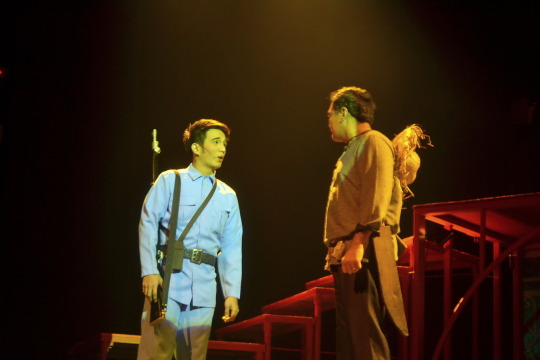
Photo of the confrontation between Tales and Tano where Tano sings about his frustration with his father posted by Jayson Pascua
Desolate and distraught at the loss of his family, Tales gets visited by a diwata (a forest spirit/fairy) and this part was extremely out of left field and absolutely not in the books.
Here, the diwata shows Tales visions of the future (???) and directly tells him, without any sort of subtlety, that the working class, and especially farmers like him, will continue to struggle in his country in the future. He is then shown a scene of farmers in a protest who were then taken down by police in what I remember as riot gear. He contemplates the future and is further given resolve to continue his rebellion.
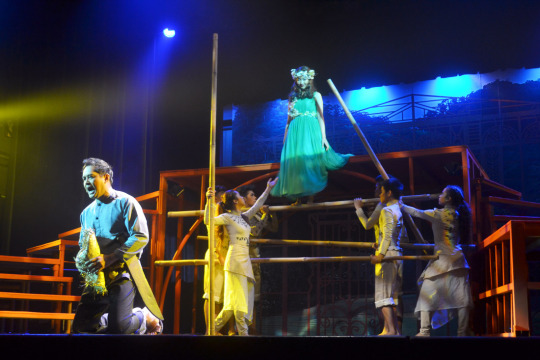
Photo of the mentioned scene where Tales first meets a diwata who will later send him to the future posted by Jayson Pascua

Photo of the mentioned scene where Tales is sent to the future by a diwata to witness farmers being taken down by cops in riot gear posted by Jayson Pascua

Another photo of the mentioned scene where Tales is sent to the future by a diwata to witness farmers being taken down by cops in riot gear posted by Jayson Pascua
I need to cut in and say that this was so on the nose and is by far the weirdest and personally maybe the worst part of the show. I'm not even against the message, it just ruined my immersion and just left a weird taste in my mouth. I think the play was doing a plenty good job driving that point across already without the time travel diwata scene but maybe that's just me.
The scene cuts back to the climax of the story where Basilio, distraught over then death of Juli, finally joins Ibarra as they plant a bomb in a wedding reception that the Governor-General of the Philippines was attending. The scene plays out like it was in the books where the lamp gets tossed out by Isagani and the revolution doesn't start.
It goes back to a scene of Tales and his men trying to fight the Guardia Civil where he is shot and killed in action, by the gun of his own son. Tano realizes what he has done and is horrified. This leads to a song which later leads to a finale that sings about Tales as the cast come together for the curtains to close.
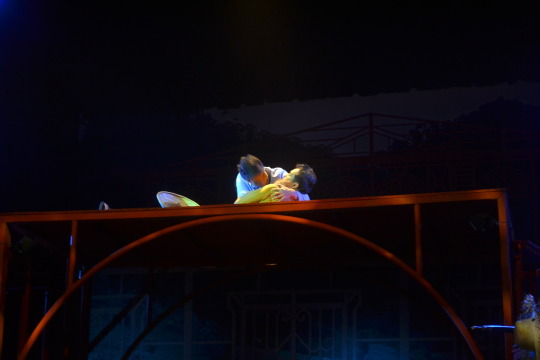
Photo of the mentioned scene where Tales is shot and killed by his son Tano posted by Jayson Pascua

Another photo of the mentioned scene where Tales is shot and killed by his son Tano posted by Jayson Pascua
The musical ends and the cast is called on to the stage one by one, with the loudest applause going to Basilio who a lot of the girls found hot, and of course, the man himself, Kabesang Tales.

Photo of the closing song with Tales being shown front and center posted by Jayson Pascua
After the play and final thoughts
Ricky Lee actually attended the performance I watched and I remember so many people crowding around the actors to get their autographs. My sister bought one of Ricky Lee's book, his script writing guide "Trip to Quiapo" and had it signed but she genuinely can't find it anymore sadly. My sister also got the autograph of some of the actors and the director on that same book so I'm a little miffed that we can't find it.
I would discuss more things and even show off my old ticket but I'm pretty sure that I would end up doxxing myself if I speak any more details.
That's all I remember from it and I would love to say more or even discuss the songs but as you can see, I could barely remember them, with only maybe a solid grasp in about maybe four songs.
It's a shame that it doesn't have as much of an established release and media presence because despite that one glaring issue I had with the weird diwata scene, I quite enjoyed the musical and it remains one of the few that I actually got to experience live.
It isn't Les Miserables or Hamilton, but it's still a musical I'll probably fondly remember especially since El Filibusterismo is one of my favorite books of all time with the character of Kabesang Tales being one of the most interesting — a man of honor and virtue who slowly descends into extremist violence because society had failed him. It's sad to see this musical barely recognized and very little talked about today and I do hope that it will one day return to the stage.
References
Introduction
Palakat Batangas City. (2015, May 29). "The Batangas City Government and Red Lantern Production present Ricky Lee’s KABESANG TALES - Isang Rap en Rol Musical." [image]. Retrieved on 17 February 2024, from https://web.facebook.com/palakat.batangascity/photos/a.1543377512565520/1636600273243243/?type=3&_rdc=1&_rdr
Background
El Filibusterismo (@joseriz15155899). (2019, November 13). "#TheFilibuster Ventura's salvificact made Rizal gave his original manuscript of El Filibusterismo, a pen and an autograph printed copy." [image]. Retrieved on 17 February 2024, from https://twitter.com/joseriz15155899/status/1194459895657041920
Inquirer. (2015, December 12). John Arcilla stars in Ricky Lee ‘rap en rol’ musical ‘Kabesang Tales’. LIFESTYLE.INQ. Retrieved on 17 February 2024, from https://lifestyle.inquirer.net/215824/john-arcilla-stars-in-ricky-lee-rap-en-rol-musical-kabesang-tales/
Inquirer. (2015, August 29). Ricky Lee writes rap, hip-hop libretto for new musical ‘Kabesang Tales’. LIFESTYLE.INQ. Retrieved on 17 February 2024, from https://lifestyle.inquirer.net/204943/ricky-lee-writes-rap-hip-hop-libretto-for-new-musical-kabesang-tales/
Lee, R. (2015, August 29). Ricky Lee: “I have been longing to do a musical, music being a driving passion in my life.” PHOTO FROM RICKY LEE [image]. LIFESTYLE.INQ. Retrieved on 17 February https://lifestyle.inquirer.net/204943/ricky-lee-writes-rap-hip-hop-libretto-for-new-musical-kabesang-tale
Red Lantern Productions. (2015, December 2012). John Arcilla. PHOTO FROM RED LANTERN PRODUCTIONS [image]. LIFESTYLE.INQ. Retrieved on 17 February 2024, from https://lifestyle.inquirer.net/215824/john-arcilla-stars-in-ricky-lee-rap-en-rol-musical-kabesang-tale
Performances and Releases
Kabesang Tales - Isang Rap en Rol Musical. (2019, July 27). Picture of the audition announcement posted on Facebook [image]. Retrieved on 17 February 2024, from https://web.facebook.com/kabesangtalestherockmusicale/photos/a.459803204196123/1309076952602073/
pheejaypi. (2016, October 3). Kabesang Tales: Isang Rap en Rol Musical clip 1 [video]. Retrieved on 17 February 2024, from https://www.youtube.com/watch?v=jftRyZOpxAA&list=PL1Yv-w-s-ETvRYsDWtaMPw2q0QO0q8Nfc
pinoy music maestro. (2021, January 1). Kabesang Tales excerpts feat. John Arcilla and Terence Guillermo [video]. Retrieved on 17 February 2024, from https://www.youtube.com/watch?v=QlOkDi8_D_A
Red Lantern Production. (2015, August 15). Kabesang Tales Trailer [video]. Retrieved on 17 February 2024, from https://www.youtube.com/watch?v=6CKKJsuBiuc
Plot
Pascua, J. (2015, October 11). Various photos [images]. Retrieved on 17 February 2024, from https://estranghero.weebly.com/photo-blog/john-arcilla-on-ricky-lees-kabesang-tales-isang-rap-en-roll-musical
#filipinfodump#filipino#philippines#filipino theatre#filipino musicals#musical theatre#musicals#filipino music#el filibusterismo#kabesang tales - isang rap en rol musical#kabesang tales#jose rizal#ricky lee#violence tw#sa tw#police brutality tw#police violence tw#mod maya
22 notes
·
View notes
Text
Remarkable Writers In The Different Periods
Period of Activism
1. Ponciano B. Peralta Pineda
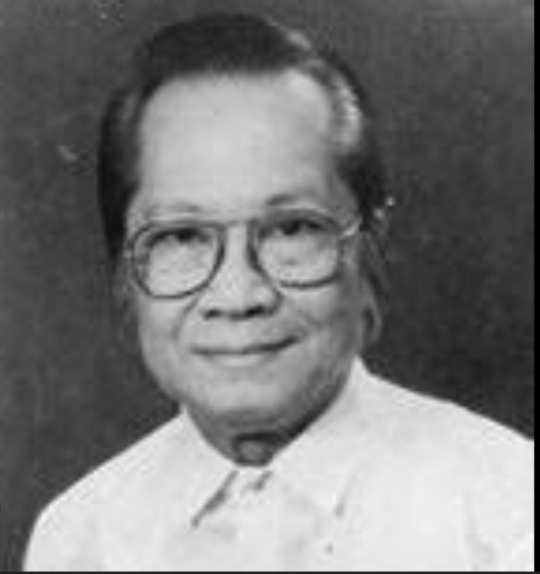
Filipino author, educator, linguist, and attorney Ponciano B. Peralta Pineda. Due to his support for the creation of a commission under Section 9 of the Philippine Constitution, Ponciano Pineda is regarded as the "Father of the Commission on Filipino Language"[1].
From 1971 to 1999, he served as the director of the Commission on the Filipino Language, formerly known as the Surian ng Wikang Pambansa (Filipino: Komisyon sa Wikang Filipino). Pineda began sociolinguistic studies to broaden the Filipino language under his direction.
reference:https://en.wikipedia.org/wiki/Ponciano_B._P._Pineda
2. Jose "Pete" Lacaba

Jose "Pete" Lacaba - A poet, journalist, and screenwriter, Lacaba's works often dealt with the themes of social injustice, oppression, and resistance. He is the author of "Days of Disquiet, Nights of Rage" and "Mga Kagila-gilalas na Pakikipagsapalaran sa mga Himala."
reference: https://en.m.wikipedia.org/wiki/Pete_Lacaba
Post Edsa Writer
1. Jose Dalisay Jr.
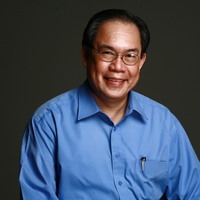
Jose Dalisay Jr. - Also known by his pen name, Butch Dalisay, he is a multi-awarded writer and essayist who has authored numerous books and articles, including "Killing Time in a Warm Place" and "Soledad's Sister."
reference: https://en.m.wikipedia.org/wiki/Jose_Dalisay_Jr.
2.Nick Joaquin
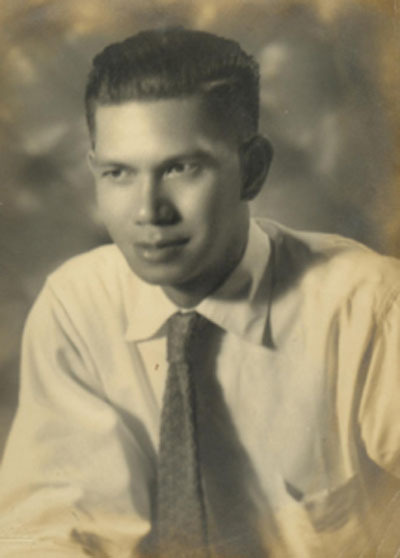
Nick Joaquin - A well-known writer and historian, Joaquin's works often explore the complexities of Philippine history and culture. Some of his notable works include "The Woman Who Had Two Navels" and "Cave and Shadows."
reference:https://en.m.wikipedia.org/wiki/Nick_Joaquin
Pre- Colonial Period
1. José Protasio Rizal Mercado y Alonso Realonda
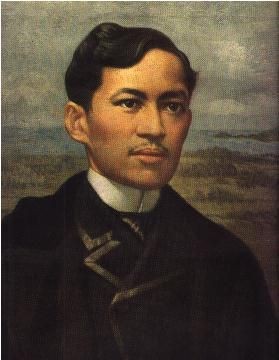
was a Filipino nationalist, writer, and polymath active at the conclusion of the Spanish colonial period of the Philippines (Spanish: [xose rizal, -al], Tagalog: [hose isal]; June 19, 1861 - December 30, 1896). He is regarded as the national hero (pambansang bayani) of the Philippines.[8][9] A writer and prominent figure in the Filipino Propaganda Movement, which promoted political reforms for the colony under Spanish rule, Rizal was an ophthalmologist by trade.
reference: https://en.m.wikipedia.org/wiki/Jos%C3%A9_Rizal
2. Marcelo H. Del Pilar

Marcelo Hilario del Pilar y Gatmaitán[2] (Spanish: [mae.lo i.la.jo el pila]; Tagalog: [mase.lo la.jo del pla]; August 30, 1850 – July 4, 1896), also known as Marcelo H. del Pilar, a Filipino author, lawyer, journalist, and freemason also known by his pen name Pláridel,[3][4] was also a writer. Del Pilar, along with Graciano López Jaena and José Rizal, rose to prominence as the head of the Reform Movement in Spain. [5]
reference: https://en.m.wikipedia.org/wiki/Marcelo_H._del_Pilar
Period Of Enlightenment
1. Antonio Luna
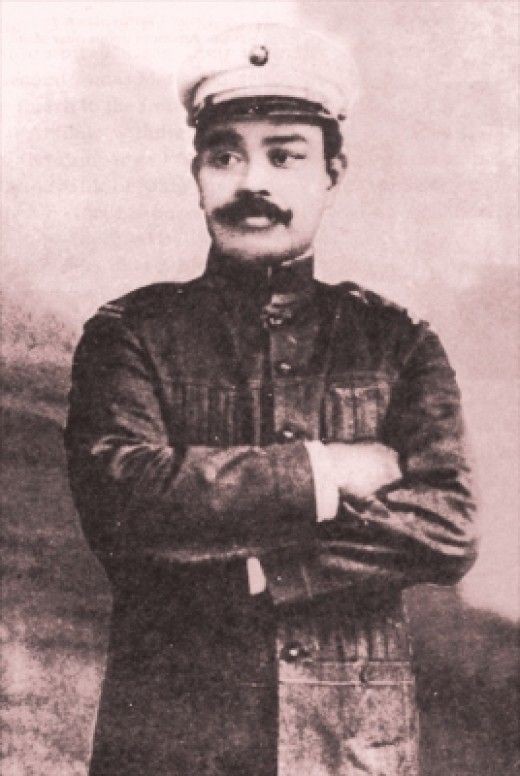
Before being assassinated on June 5, 1899, at the age of 32, Antonio Narciso Luna de San Pedro y Novicio Ancheta (Spanish: [antonjo luna]; October 29, 1866 - June 5, 1899) was a Filipino army commander who participated in the Philippine-American War.
reference: https://en.m.wikipedia.org/wiki/Antonio_Luna
2. Mariano Ponce y Collantes

Mariano Ponce y Collantes was a Filipino physician, author, and prominent propagandist who lived from March 22, 1863, until May 23, 1918. He helped form La Solidaridad and Asociación Hispano-Filipina in Spain. Efemerides Filipinas, a column on Philippine historical events that published in La Oceania Espaola (1892-1893) and El Ideal (1911–1912), was one of his notable works. In 1917, he published Ang Wika at Lahi, a discourse on the value of a national tongue. From 1909 to 1912, he also represented Bulacan in the Philippine Assembly.
reference:https://en.m.wikipedia.org/wiki/Mariano_Ponce
American Regime
1. Carlos P. Romulo

John Carlos Pea Romulo Jr. Filipino politician, statesman, soldier, writer, and author QSC GCS CLH NA GCrM GCrGH KGCR (January 14, 1898 – December 15, 1985). At the ages of 16, 20, and 32, he was a newspaper editor, a reporter, and a publisher. He co-founded the Boy Scouts of the Philippines, served as a general in both the US and Philippine armies, served as president of a university, and presided over the UN General Assembly.
reference:https://en.m.wikipedia.org/wiki/Carlos_P._Romulo
2. Paz Marquez Benitez

Paz Márquez-Bentez was a Filipino short story writer, educator, and editor (March 3, 1894 – November 10, 1983). Her career as a woman educator and writing contributions are seen as important steps within the advancement of women in professional careers as well as in the development of Philippine literature.
reference: https://en.m.wikipedia.org/wiki/Paz_M%C3%A1rquez-Ben%C3%ADtez
Photo Credits:
1st Img:https://www.google.com/imgres?imgurl=https%3A%2F%2Ftse1.mm.bing.net%2Fth%3Fq%3DPonciano%2BPineda&tbnid=WZC1z6oKPrB55M&vet=1&imgrefurl=https%3A%2F%2Fphschooli.github.io%2Fponciano-pineda.html&docid=63bXGiguB_cStM&w=150&h=154&itg=1&hl=en-US&source=sh%2Fx%2Fim
2nd Img: https://images.app.goo.gl/hTeHAivnMqeT748R7
3rd Img: https://www.google.com/imgres?imgurl=https%3A%2F%2F0.academia-photos.com%2F25515653%2F6973447%2F7863375%2Fs200_jose.dalisay.jpg&tbnid=NBSPTbqqnb2dTM&vet=1&imgrefurl=https%3A%2F%2Fup-diliman.academia.edu%2FJoseDalisay%2FCurriculumVitae&docid=nlqpiPJ0mbNdFM&w=200&h=200&hl=en-US&source=sh%2Fx%2Fim
4th Img: https://www.google.com/imgres?imgurl=https%3A%2F%2Fimages.gr-assets.com%2Fauthors%2F1271904633p8%2F74757.jpg&tbnid=nbm2NL2FMdmm0M&vet=1&imgrefurl=https%3A%2F%2Fwww.goodreads.com%2Fauthor%2Fshow%2F74757.Nick_Joaqu_n&docid=4DO2yFYXFPsVFM&w=400&h=558&hl=en-US&source=sh%2Fx%2Fim
5th Img:
https://pin.it/51o5z7r
6th Img:
https://pin.it/4iGGdMy
7th Img:
https://www.google.com/search?gs_ssp=eJzj4tTP1TdIzzA2NjVg9OLNTSzKTMzLVyjIz0tOBQBjjwgd&q=mariano+ponce&oq=Ma&aqs=chrome.3.69i60l3j46i39i650j69i60j69i57j69i59j69i60j46i67i650j0i67i433i650.1648j0j4&client=ms-android-transsion&sourceid=chrome-mobile&ie=UTF-8#imgrc=6iTmTDQzbONVuM&lnspr=W251bGwsbnVsbCxudWxsLG51bGwsbnVsbCxudWxsLG51bGwsbnVsbCxudWxsLG51bGwsbnVsbCxudWxsLG51bGwsbnVsbCxudWxsLG51bGxd
8th Img:
https://pin.it/1lXfM0v
9th Img:
https://www.google.com/imgres?imgurl=https%3A%2F%2Fcdn.tatlerasia.com%2Ftatlerasia%2Fi%2F2023%2F03%2F03132943-paz-f_cover_1600x900.jpg&tbnid=EcJM6sXtpjA_9M&vet=1&imgrefurl=https%3A%2F%2Fwww.tatlerasia.com%2Flifestyle%2Farts%2Fpaz-marquez-benitez&docid=dYhHL_yuRQCKCM&w=1600&h=900&source=sh%2Fx%2Fim
10th Img:
https://www.google.com/search?client=ms-android-transsion&sxsrf=APwXEdeh3fEJ-aNLwLWVyG2H1Gu4KjrUOQ:1683042906425&q=julian+cruz+balmaceda&tbm=isch&sa=X&ved=2ahUKEwjV09C0_9b-AhVDEnAKHWLvAV8Q0pQJegQIDBAB&biw=360&bih=728&dpr=3#imgrc=rp-VeXX39fK64M&lnspr=W251bGwsbnVsbCxudWxsLG51bGwsbnVsbCxudWxsLG51bGwsbnVsbCxudWxsLG51bGwsbnVsbCxudWxsLG51bGwsbnVsbCxudWxsLG51bGxd
5 notes
·
View notes
Text
guess who. guess who just compared fictional charcter from genshin impact Al Haitham to real-world historical figure who was kind of responsible for a revolution within my country Jose Rizal.
1 note
·
View note
Text
EDEN, PARADISE IN THE PHILIPPINES, THE LAND OF OPHIR, May 15, 2026
God has promised to give His appointed people the disclosure of the mystery, notably the set time of the end (Romans 16:25).
The garden of Eden, where Adam and Eve once lived, illustrates the paradise promised by God to His faithful people on His Second Advent.
2 CORINTHIANS 12:2, 4
(2) …such an one caught up to the THIRD HEAVEN.
(4) How that he was caught up into PARADISE, and heard unspeakable words…
REVELATION 2:7 …To him that overcometh will I give to eat of the TREE OF LIFE, which is in the midst of the PARADISE of God.
The scripture describes the garden of Eden as being situated in the land of Havilah, which is rich in gold.
GENESIS 2:8, 10-11
(8) And the LORD God planted a garden EASTWARD in EDEN…
(10) And a river went out of Eden to water the garden; and from thence it was parted…
(11) The name of the first is Pison: that is it which compasseth the whole land of HAVILAH, where there is GOLD;
GENESIS 3:24 So he drove out the man; and he placed at the EAST of the garden of EDEN Cherubims… to keep the way of the TREE OF LIFE.
Havilah is the brother of Ophir, residing at Sephar, which is a mount in the east, whose descendants were being chronicled as belonging to the tribe of Shem (Genesis 10:22, 29-30).
Philippines is one of the far-eastern countries of Asia as being recorded in the World Atlas.
Dr. Jose Rizal, a polymath and a historian, has declared the Philippines an oriental country and “Eden Lost” in his poem, “MI ÚLTIMO ADIOS (My Last Farewell).”
Thus, the word “OPHIR” is a prophetic acronym for the “REPUBLIC OF THE PHILIPPINES.”
God directed His people to Genesis 1:1, for He has now revealed the appointed time of the end from the beginning.
ISAIAH 46:10, 11
(10) DECLARING the END from the BEGINNING, and from ancient times the things that are not yet done…
(11) Calling a ravenous bird from the EAST, the man that executeth my counsel from a FAR COUNTRY…
The word “ELOHIM,” which refers to “GOD” in Genesis 1:1, was mentioned 2,602 times In the Hebrew Tanakh, a flipped figure of 2026, the exact year of Christ’s return.
Biblically, the gold that Solomon receives once every 3 years came from the land of Ophir, which has a weight of about 666 talents (1 Kings 10:11, 14).
SIX HUNDRED THREESCORE and SIX = 666 (number of the Beast – PAPACY)
Ophir has a numerical value of 666.
O – 15, P – 16, H – 8, I – 9, R – 18
15 + 18 = 33 (3 + 3 = 6)
16 + 8 + 9 = 33 (3 + 3 = 6)
6 x 6 = 36
The Triangular number of 36 is 666.
6 x 6 x 6 = 216
Historically, on March 16, 1521, the Philippines was rediscovered by Ferdinand Magellan as he led a Spanish voyage to the East Indies.
MARCH (3rd month) 16, 1521
3 x 16 x 15 x 3 = 2160
3 + 1 + 6 + 1 + 5 + 2 + 1 = 19 (1 + 9 = 10)
216(0) + 10 = 2260 (flipped figure of 2026)
In these last days, God will restore the land of Eden as He gathers His people out of all countries (Ezekiel 36:24,35).
The restoration of Eden portrays the gathering of God’s redeemed on His Second Advent and to finally dwell in the heavenly paradise.
JOEL 2:1, 3
(1) Blow ye the TRUMPET in Zion, and sound an alarm in my holy mountain… for the day of the LORD COMETH…
(3) …the land is as the garden of EDEN before them, and behind them a desolate wilderness…
The word “EDEN” has a numerical value of 2026, the exact year of Christ’s return.
E – 5, D – 4, E – 5, N – 14
5 + 4 + 5 + 14 = 28 (2 + 8 = 10)
Taking the cube of numbers 1-10 as per digit will give a sum of 2026, the exact year of Christ’s return.
MARK 1:15 The TIME IS FULFILLED, and the kingdom of God is at hand: REPENT ye, and BELIEVE the gospel.
TO GOD BE THE GLORY!
#reelsviralシ #fypシ #fbviral #fbreelsfypシ゚ #reelsviralシ #reelsfbシ #viralshorts #JesusIsLord #Jesusiscoming #Rapture #endtimes #prophecy #bible #SignsOfTheTimes #ophir #gardenofeden #doomsday #apocalypse #apostolic #Armageddon #heaven #SavedByGrace #EternalLife
0 notes
Text
Get to know History by exploring streets around UST
The University of Santo Tomas (UST), located along España Blvd, Sampaloc Manila, is one of the leading universities across the Philippines. Founded on April 28, 1611. UST has a rich history surrounded by street names with historical backgrounds connected to our national hero, Dr. Jose Rizal.
Dr. Jose Rizal in UST
José Protacio Rizal Mercado y Alonso Realonda, known as Dr. Jose Rizal, studied at the University of Santo Tomas when he was only 16 years old, from April 1877-1882. He finished a program in Philosophy and Letters before shifting to a medicine program and leaving the country to continue his studies in Spain.
While at UST, Rizal wrote several poems, including “A la Juventud Filipina” (To the Filipino Youth), which was dedicated to the Filipino youth during the Spanish oppression, urging them to use their talents and potential to shape the future of our country.
Additionally, he also founded a secret society called Compañerismo, whose members are called “Companions of Jehu”.
Street names around UST historically related to Dr. Jose Rizal
1. Laong Laan St.
Laong Laan was Dr. Jose Rizal’s pen name when he was a contributor of poems and articles in “La Solidaridad,” an organization that later became a newspaper based in Barcelona, Spain. Established on February 15, 1889, by Filipino exiles, serving as a platform for Filipino nationalists advocating for political reforms and social justice in the Philippines during the Spanish colonial rule.
Laong in Tagalog means “a long time” while “laan” means “reserved for a purpose”. Therefore, Laong Laan conveys as “kept in reserve for a purpose for a long time”
2. Dimasalang St.
Dr. Jose Rizal also wrote under the pseudonym “Dimasalang” when he was a correspondent for the same newspaper “La Solidaridad”. He published a literary piece titled “El Amor Patrio” (Love of Country) during his time in Spain. It was later on included in “Diariong Tagalog”, a daily newspaper established in Manila.
3. Blumentritt Road
Blumentritt Road is named after Ferdinand Blumentritt who became Rizal’s closest friend. His friendship with the national hero dates back to as early as July 1886. They often exchanged letters that were used as significant sources for historians prior to Rizal’s execution on December 30, 1896.
4.España Boulevard
España Boulevard was named after the Spanish word for the country Spain, which became the colonial power that governed the Philippines for 333 years.
5. Dapitan Street
Dapitan Street was derived from the coastal town of Dapitan in Zamboanga del Norte where Dr. Jose Rizal was exiled from July 17, 1892, until July 31, 1896.
7.Piy Margal Street
Piy Margal Street was followed by Pio del Pilar Margal who was a Filipino general in the Philippine Revolution, although not entirely connected to Rizal, he was still one of the figures who fought for the Philippine Independence
Additional streets inspired by Dr. Jose Rizal’s novels;
Here is the list of street names that were inspired by the characters of Dr. Jose Rizal’s novels, “Noli me Tangere” and “El Filibusterismo”.
1. Ma. Clara St.
2. Tiago St.
3. Isagani St.
4. Crisostomo St.
5. Ibarra St.
6. Simoun St.
7. Elias St.
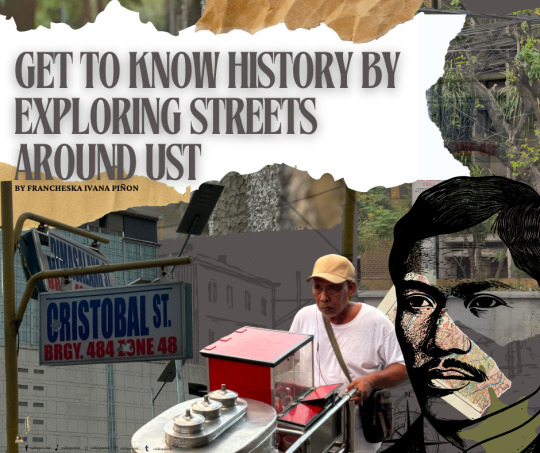
Written by: Francheska Ivana Piñon
Pubmat & Photo by: Jackielou Almajose
0 notes
Text
Dr. Jose Rizal Statue
Who is your favorite historical figure?
José Protasio Rizal Mercado y Alonso Realonda was a Filipino nationalist, writer and polymath active at the end of the Spanish colonial period of the Philippines. He is considered the national hero (pambansang bayani) of the Philippines. We’ve been studied his life and his journey as part of our history and how he become our national hero through through…

View On WordPress
0 notes
Text
Conclusion
The Enlightenment period, also known as the Age of Reason, began in the 17th century and continued into the 18th century. It was a time of intellectual and cultural revolution in Europe, marked by the rise of science, reason, and individualism. Some key figures of the Enlightenment include John Locke, Voltaire, and Jean-Jacques Rousseau.
In the Philippines, the ideas of the Enlightenment had a significant impact on the movement for reform and independence from Spanish colonial rule. The Ilustrados, a class of educated and enlightened Filipinos, sought to implement social and political reforms modeled after European Enlightenment ideals. They also promoted the use of reason, science, and education as sources of progress and national identity.
The Philippine Revolution, which began in 1896, aimed to overthrow the Spanish colonial government and establish an independent republic. The revolution was led by Filipino nationalist figures such as Andres Bonifacio, Emilio Aguinaldo, and Jose Rizal. After a long struggle, the Philippines achieved independence from Spain in 1898, but it was soon colonized by the United States.
Under American colonial rule, the Philippines underwent significant modernization and development, particularly in infrastructure, education, and governance. However, it also experienced political repression and exploitation, which led to the rise of various political movements and parties.
In 1946, the Philippines gained full independence from the United States, which marked the beginning of the post-independence era. The country was then governed by different administrations, including the Marcos regime. The latter was characterized by authoritarian rule, political corruption, and human rights violations, which sparked widespread protests and resistance from various sectors of society.
The People Power Revolution, also known as the EDSA Revolution, was a nonviolent uprising that ousted the Marcos dictatorship in 1986. This historical event was a result of widespread public discontent with the regime's abuses, which led to the active participation of civil society, the Catholic Church, and the military in the overthrow of the government. It is considered a triumph of democracy and has become a symbol of peaceful resistance for people all over the world.
Since then, the Philippines has undergone significant changes and reforms in its political, economic, and social systems, but it continues to face various challenges, including poverty, corruption, and political instability. However, the spirit of the Enlightenment and the struggle for freedom, justice, and equality continues to inspire Filipinos to work towards a better future for the country.
0 notes
Text
REMARKABLE FILIPINO WRITERS IN DIFFERENT PERIOD
Don Carlos Palanca

The Don Carlos Palanca Memorial Awards for Literature, popularly known as the Palanca Awards, are a set of literary awards for Philippine writers. Usually referred to as the "Pulitzer Prize of the Philippines", it is the country's highest literary honor in terms of prestige. Winning works are entered in the competition either as previously published pieces or in manuscript form.[1] The Palanca Awards, organized by the Carlos Palanca Foundation, is one of the Philippines' longest-running awards programs.[2]
Don Carlos Palanca Memorial Awards for Literature
Jose Rizal
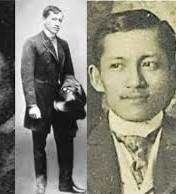
José Protasio Rizal Mercado y Alonso Realonda[7] (Spanish: [xoˈse riˈsal, -ˈθal], Tagalog: [hoˈse ɾiˈsal]; June 19, 1861 – December 30, 1896) was a Filipino nationalist, writer and polymath active at the end of the Spanish colonial period of the Philippines. He is considered the national hero (pambansang bayani) of the Philippines.[8][9] An ophthalmologist by profession, Rizal became a writer and a key member of the Filipino Propaganda Movement, which advocated political reforms for the colony under Spain.
Rizal c. 1890s
Born
José Protasio Rizal Mercado y Alonso Realonda[1]
June 19, 1861[2]
Calamba, Laguna, Captaincy General of the Philippines, Spanish Empire[2]
Died
December 30, 1896 (aged 35)[3]
Bagumbayan, Manila, Captaincy General of the Philippines, Spanish Empire[3]
Cause of death
Execution by firing squad
Resting place
Rizal Monument, Manila
Monuments
Daet, Camarines Norte
Luneta Park, Manila
Calamba, Laguna
Other names
Pepe, Jose (nicknames)[4][5]
Alma mater
Ateneo Municipal de Manila (BA)
University of Santo Tomas
Universidad Central de Madrid (MD)
Organization(s)
La Solidaridad, La Liga Filipina
Notable work
Noli Me Tángere (1887)
El filibusterismo (1891)
Movement
Propaganda Movement
Spouse
Josephine Bracken (m. 1896)[6]
Parents
Francisco Rizal Mercado (father)
Teodora Alonso Realonda (mother)
Relatives
Saturnina Hidalgo (sister)
Paciano Rizal (brother)
Trinidad Rizal (sister)
Signature
Jose rizal signature.svg
He was executed by the Spanish colonial government for the crime of rebellion after the Philippine Revolution broke out; it was inspired by his writings. Though he was not actively involved in its planning or conduct, he ultimately approved of its goals which eventually resulted in Philippine independence.
Rizal is widely considered one of the greatest heroes of the Philippines and has been recommended to be so honored by an officially empaneled National Heroes Committee. However, no law, executive order or proclamation has been enacted or issued officially proclaiming any Filipino historical figure as a national hero.[9] He wrote the novels Noli Me Tángere (1887) and El filibusterismo (1891), which together are taken as a national epic, in addition to numerous poems and essays.
0 notes
Text
2 REMARKABLE WRITERS IN DIFFERENT PERIODS
The Period of Enlightenment
Jose P. Rizal

Credit Picture:
José Protasio Rizal Mercado y Alonso Realonda was a Filipino nationalist, author, and polymath who was active toward the conclusion of the Spanish colonial period in the Philippines (June 19, 1861 – December 30, 1896). He is regarded as the Philippines' "pambansang bayani," or national hero. Rizal, an ophthalmologist by training, later turned to writing and was a vital figure in the Filipino Propaganda Movement, which pushed for political reforms in the colony that Spain ruled.
Following the start of the Philippine Revolution, which was sparked by his writings, he was put to death by the Spanish colonial government for the crime of rebellion. Although he did not actively participate in its planning or execution, he ultimately supported its objectives, which led to the independence of the Philippines.
Jose Rizal is the greatest heroes of the Philippines who have been suggested to be so honored by a National Heroes Committee that has been formally appointed. No law, executive order, or proclamation, however, has been passed or issued officially designating any historical individual from the Philippines as a national hero. Along with numerous poems and essays, he also produced the two novels Noli Me Tángere (1887) and El filibusterismo (1891), which taken together constitute a national epic.
Source:
Marcelo Hilario Del Pilar

Credit Picture:
A propagandist and satirist for the Philippine revolution, Marcelo H. Del Pilar (1850–1896). He attempted to mobilize the anti-Spanish imperialist feeling of the well-educated Filipino ilustrados, or bourgeoisie.
On August 30, 1850, Marcelo Del Pilar was born to educated parents in Kupang, Bulacan. He completed his legal studies at the University of Santo Tomas in 1880 after completing his studies at the Colegio de San José. Del Pilar challenged prejudice and hypocrisy while standing up for the disadvantaged victims of racial discrimination in court, driven by a sense of justice against the clergy's misdeeds. He advocated the importance of hard effort, self-esteem, and respect for others. His command of his native tongue, Tagalog, allowed him to raise the general public's awareness of the need for cooperation and steadfast opposition against the despots in Spain.
Source:
1 note
·
View note
Text





Rizal and Culture
"Rizal was an artist. He drew, painted and sculpted. In his travels, he sketched landscapes and people. He studied the Philippine dialects and foreign tongues. He was a good poet and writer. His words flowed in his odes, hymns, stories, plays and novels. In his writings, he promoted the rich culture of prehispanic Filipinos, their legends and their traditions."
#who allowed him to be so talented#'nay teodora im looking at u#jose rizal#jose protacio rizal#national hero#pambansang bayani#rizal shrine#dambana ni rizal#fort santiago#manila#intramuros#art#sketches#drawings#ph historical figures
45 notes
·
View notes
Text
Reflection Paper
Villamor, Rinalyn L.

Bayanihan
“Art should comfort the disturbed and disturb the comfortable.” – Cesar A. Cruz.
Paintings will always fascinate me. Whenever I see one in person, I tend to get close to it to see the pattern of brush strokes on the canvas and then I would just stare at it for a moment, taking my time to see every pattern that has been put on it and thinking what inspires the artist to make such a great masterpiece. Whenever I see one on social media, I would click the picture and zoom it in because I really like to see the detailing of the artwork. Not long after that, I would find myself checking the profile of an artist I just admired.
Paintings for me are like a story, created to always be remembered. It represents an important event that should not be forgotten but sometimes, a painting or an art in general does not have any story behind it. It can be less about history, lives, and things and more on lines, shapes, and colors.
When we were given a chance to talk about fond artists and artworks, a person who instantly appears on my mind is no other than Carlos „Botong‟ Francisco. A Filipino muralist considered as one of the most important wall painters and is famous for his historical paintings. In 1914, Botong was born and raised in Angono, a town in the Philippine province of Rizal. Francisco attended the School of Fine Arts at the University of the Philippines. He made graphics for the Tribune and La Vanguardia before the war, and afterwards painted sets for the Manila Grand Opera House and the Clover Theater with Victorio Edades and Fermin Sanchez. After WWII, Francisco taught at the University of Santo Tomas while still working in filmmaking as a playwright and costume designer with Miguel Conde
Francisco was also a member of the "Thirteen Moderns," an avant-garde group founded in 1938. He was one of the first group of Filipino modernists, alongside Edades and Galo B. Ocampo, who pioneered the transition of Philippine art from the Amorsolo school to the modernist movement. A number of murals with stylized figures in flowing, serpentine lines were commissioned by Francisco, Edades, and Ocampo. The artists contributed to the development of a Filipino iconography through these works, drawing influence from Filipino customs and traditions, as well as familiar locations. Francisco used bright folk colors, rhythmic lines, and colorful patterns in his work. He invoked the community life of Filipino festivities and gatherings. His paintings were inspired by mythology, history, legend, and modern village life in the Philippines.
If I were to choose on one of his paintings, the one that strike me the most is his Bayanihan mural painting, commissioned in 1962 by UNILAB founder Jose Y. Campos. Bayanihan is oil on canvas painting refers to the Filipino community spirit, as well as the actual practice of villagers literally taking a home upon their collective shoulders and moving it to a new location. The Bayanihan spirit embodies the Filipino concept of helping and supporting one another without expecting anything in return, especially in times of need.
As for my interpretation of the Bayanihan painting, this conveys the idea that there is no great weight on a caring and helpful community. This artwork is also a fantastic illustration of the uplifting wave of goodness that began one year ago, mid of April 2020. When a group of friends established a community pantry on Maginhawa St. in Quezon City, they encouraged people to give according to their means and take according to their needs. From farmers to health care workers, everyone came together to fight hunger and exemplify bayanihan, or "gathering
communal effort," which made me feel that there is still hope and goodwill in our society despite the lack of official support. Today, the term bayanihan has taken on many different meanings and has been used as a codename for initiatives that show the spirit of collaboration among a group of people.
References:
Moya, Jove (2021) “National Artist Trivia: Who Was Carlos "Botong" Francisco?” Tatler https://www.tatlerasia.com/culture/arts/carlos-botong-francisco
Project Bayanihan (2022) “Bayanihan” http://groups.csail.mit.edu/cag/bayanihan/
11 notes
·
View notes
Text
Notes and References for i know your eyes in the morning sun
Hi! These are notes and references for my IndoPhil fic i know your eyes in the morning sun, so please check it out before reading this!
Title: i know your eyes in the morning sun
Summary: When a homesick Indonesia is unexpectedly taken out of his meeting for a day trip in Rome with Philippines, he isn't expecting much more than exhaustion ahead of him. Instead, what happens is a whirlwind of food, fun, and a surprising amount of reflection on their histories and differences as nations. And as he looks deeper and deeper in the other nation's bright eyes, he learns to come to terms with the feelings he's been ignoring for far, far too long. Alternatively: a nation who's too attached to the past goes on a date with a nation whose entire philosophy is built on trying to live in the moment. Yes, there is kissing involved.
Read on: AO3 | FF.net
Scene 1: Pizza al taglio

As coincidence would have it, the G20 2021 Summit actually will be held in Rome, Italy. However, it’ll be on the end of October rather than the end of September like how its depicted in the fic. I’m also very much ignoring the COVID-19 pandemic. Pretend it never happened.
Borobudur is the largest Buddhist temple in the world, found in the island of Java, Indonesia. It was built way back in the 7th Century and it's probably Indonesia's top most visited site.
Terang bulan is basically like a really large, fluffy, folded pancake. It also has a variety of different names and is also eaten in Brunei, Malaysia, and Singapore.
If you could have a convenience store dedicated solely to pizza, that's what pizza al taglio establishments are like. Its literal translation is pizza by the cut, and since it's a lot more common to find in Rome than in other places in Italy, it's also called Roman-style pizza. The layout for the al taglio shop that Indonesia and Philippines go to is inspired from the shop that me and my family went to: a small family establishment just a short walk away from the Vatican.
You can actually find a recipe for Indonesia’s arugula and mozzarella pizza here: https://shared.publicmediaconnect.org/docs/atk/Pizza_Taglio_Cooks_Illustrated.pdf
Scene 2: Souvenir store + Bus stop


Indonesian rupiahs are notoriously hyperinflated, so the 15 euros that Philippines uses to buy the keychains convert to 250k+ rupiahs. That's around 50k short for actually being able to buy a local economy flight on Lion Air. For comparison, the same amount of euros convert to approximately 900 Philippine pesos. It’s also a few hundred pesos short of buying a local economy flight on Cebu Pacific.
There actually was a point when a G20 meeting was held in the Coliseum. It was the G20 culture ministers meeting just a few months ago, in July 2021.
Yes, on top of the thousands of festivals we already have, Filipinos also celebrate Oktoberfest! It's more of an excuse for local beer companies to shamelessly promote their product and encourage drinking fests on a massive scale, but a more legitimate Oktoberfest celebration is organized by the German Club in Manila. Lucky Philippines gets to celebrate it authentically in Munich with the German brothers, who historically aimed to conquer the Philippines before America managed to stake his claim. So if you sense that Germany is being oddly shy towards Philippines here, that's just Germany being embarrassed because of their history.
Italy's major international airport in Rome is Aeroporto Internazionale di Roma–Fiumicino "Leonardo da Vinci", so you generally just call it Fiumicino for short. A possible travel route for flying from the Philippines to Italy is Clark-Dubai-Rome, and another is Manila-Hong Kong-Rome.
Scene 3: Gianicolo

Bali, Boracay, and El Nido are beaches that serve as major tourist destinations.
Vietnam has already been mentioned to be a menace when she's drunk in her most recent character introduction. Laos is at the top of ASEAN when it comes to alcohol consumption, with the average Laotian drinking seven liters of pure alcohol every year.
Indonesia is sometimes known as the Invisible Nation. What this means to say is that there have not been many things that Indonesia has done that made massive waves on the global scale. From what I’ve read, this seems to have been an especially popular sentiment among Western analysts during the Cold War.
Australia's awkward attempt at an apology is a reference to when the Australian government had allegedly monitored and spied on the phone calls of several Indonesian officials. Indonesia and Australia have a history that goes far deeper than that though.
Monas is a common abbreviation for Indonesia's Monumen Nasional, proudly standing tall in the middle of Merdeka Square as a commemoration of the fight for Indonesian independence. Taman Surapati is a large, chill public park; it also has a monument dedicated to commemorating ASEAN there. Both are located in Jakarta, Indonesia's capital. Meanwhile, Philippines' mention of Luneta refers to Luneta Park. It's also known as Rizal Park, as it's the place where the national hero Jose Rizal was executed for the influence he had in encouraging the fight for Philippine independence.
In Rome, there are seven major hills: they formed the geographical heart of Ancient Rome, with Palatino and Campidoglio as the most significant given how connected they were to Rome's founding and Rome's religion. Gianicolo is outside the boundaries of Ancient Rome, and as such, it isn't counted among the seven hills. It is dedicated to the Roman god Janus and was a place for the augurs to divine the will of the gods — kind of like a prophecy, if a prophecy could be divined from bird entrails. Now it's a great spot for a scenic view of modern Rome which features, among other things, a large statue of Giuseppe Garibaldi. Garibaldi was a major figure in the Italian Reunification.
Nusantara means many different things, but in the era of the Majapahit empire, it referred to the vassal kingdoms in what is now modern-day Malaysia, Singapore, Brunei, Timor Leste, and the southern parts of modern-day Thailand and Philippines. Modern usage of the word in Indonesia generally refers to the Indonesian archipelago, but it can also be used to refer to the entirety of maritime Southeast Asia. Culturally and historically, Southeast Asia is divided into the mainland region (the countries connected to the Asian continent: Vietnam, Thailand, Cambodia, Laos, Myanmar) and maritime (the countries that are islands and archipelagos: Malaysia, Indonesia, Singapore, Brunei, Philippines).
Italy, together with the United Kingdom, is the largest European migration destination for Filipinos. The largest migration destination for Filipinos in general is America.
Shout-out to Ro-na for this wonderful headcanon of Philippines being sickly in his early days as a Spanish colony! The galleon ships used to facilitate trade between the Philippines and Mexico (perhaps the Philippines' most major contribution to the Spanish crown) would often be attacked by pirates or destroyed in typhoons, especially in the first few decades.
Majapahit and Srivijaya are only two of pre-colonial Indonesia's many powerful empires. A lot of the pre-colonial stuff has been simplified for brevity's sake, but a brief summary of it all basically goes like this: pre-colonial Indonesia was involved with everyone in maritime SEA, where everyone traded with each other; and mainland SEA was non-stop fighting where the major powers were the empires that would later become Vietnam and the Khmer empire that would influence everyone else in mainland SEA. You can find a more detailed look into mainland SEA history by Gemu in her posts here, who is my main influence for everything mainland SEA-related.
A young Brunei picking flowers for a young Philippines is a reference to all the marriages that had occurred between their nobility during the pre-colonial era.
Scene 4: Apartment
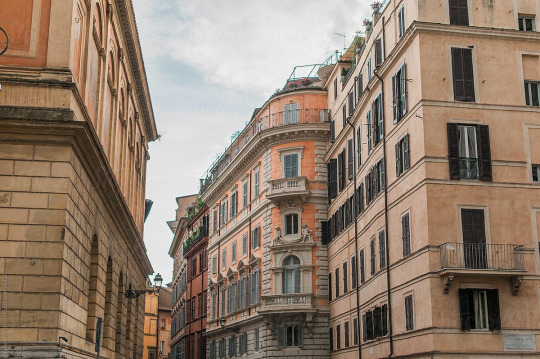
The turtle fountain in Rome is a real thing: Fontana delle Tartarughe was originally designed with dolphins in mind, but the dolphins were removed and replaced by turtles. In fandom, you usually see Philippines calling Indonesia kuya, which is Tagalog for older brother. In at least one Indonesian language (I can't remember which one at the moment, sorry!), kuya means turtle.
Tondo, Seludong, Butuan, Sulu, Sugbu, and Panay are all polities in pre-colonial Philippines, two for each of the main island groups in the country: Luzon in the north, Mindanao in the south, and Visayas in the middle. Unlike pre-colonial Indonesia, the societies in the Philippines were never united by a single kingdom or empire; the Philippine islands were only united through the efforts of Spanish and American colonization.
Filipinos tend to sing a lot. Many of us are really good at it. Karaoke is really popular here.
Philippines' PIN code of 8862 is a reference to when ASEAN was founded: August 8, 1962. The founding members were Philippines, Indonesia, Malaysia, Singapore, and Thailand.
This might be as good of a time as ever for me to mention that I am depicting Philippines and Indonesia as Catholic and Muslim respectively. Filipinos are predominantly Catholic and the Philippines is the largest Catholic country in Asia, while Indonesia has a number of official religions and is the largest Muslim nation in the world.
Special thanks to Desa for helping me with Indonesia's prayer times! Normally, Muslims pray five times a day, but when travelling Muslims are allowed to pray only three times. This is called Qasr salah, or Qasr sholat in Indonesia. What is usually Fajr (called Subuh in Indonesia), Zuhr, Asr, Magrib, and Isha becomes only Fajr, Zuhr-Asr, and Mahgrib-Isha; essentially, without getting into the specifics of time, a prayer for sunrise, afternoon, and night. The mosques will remind everyone when it's prayer time with adhan (called adzan in Indonesia), but in non-Muslim countries abroad, many Muslims have to use websites and apps to keep track. Something I didn't mention in the fic is that Rome actually has the largest mosque in the Western world, Moschea di Roma, so Indonesia could have potentially prayed there.
Scene 5: Apartment dinner table

Sholat wouldn’t take Indonesia more than a few minutes, so imagine that he did something else while waiting for Philippines to finish cooking.
Baked fish with sliced lemons is a meal that got served to me a lot in Italy. Chop suey is Chinese, but China has had a significant cultural influence for most of Southeast Asia throughout history; the Indonesian version is known as kap cay. Indomie Mi Goreng is a particularly tasty and famous kind of instant noodles from Indonesia. It's very popular in many Asian countries. Indonesia doesn’t drink, but Philippines is drinking white wine because that’s what you’re supposed to do when eating fish. Red wine goes with meat.
Admittedly, this is my own personal headcanon, but I like to think of Philippines living in Spain with the other Spanish colonies while everyone else in maritime SEA were left behind to live in their own countries. It's my own neat Hetalia universe explanation for how much Spanish influence there is in Filipino culture, and how isolated Filipinos can sometimes feel among their neighbors.
I do think that Philippines would have a Hispanic-sounding human name, but I've never really settled on what name actually would be: in fandom, Felipe, Lorenzo, and Jaime get thrown around a lot. In contrast, it seems like most people have settled on Dirga (short for Dirgantara) for Indonesia.
Philippines is sometimes called as la colonia abandonada in Spanish sources: the abandoned colony. Because the Philippines was so far away, Spain couldn't manage the colony directly and had to rely on Mexico/Nueva España to do the dirty work until Mexico became independent. This led to a more relaxed manner in how the country was managed for most of its Spanish colonial life; some scholars even go as far as saying that Spain's treatment of the Philippines was kinder than Spain's treatment of Latin America. I don't really agree — it was different, sure, but it wasn't kind in the least.
Contrast that with Indonesia as the largest and most important colony of the Dutch empire. Aside from all the money and economic prosperity that Indonesia gave to the empire, you'll also find many Dutch songs and hymns that are all praises to Indonesia. Much of the research in Indonesian history, ethnography, and archeology was made possible because of Dutch interest and support; until now, the Netherlands remains to be Europe's leader when it comes to Indonesian studies. This isn't to say that Netherlands treated Indonesia well, however.
After the Japanese occupation of Indonesia in WW2, Netherlands fought to keep power over the archipelago. Needless to say, the Netherlands failed. Indonesia was recognized as an independent country soon after.
Indië is the Dutch colonial name for Indonesia.
APEC is the Asia-Pacific Economic Cooperation, of which Philippines and Indonesia (and Thailand!) are members.
Scene 6 + 7: Apartment bedroom

What was Philippines doing in the 1920s, you ask? Being an American colony and trying to lobby for laws that would hasten his independence. Indonesia was in the middle of what’s called the Indonesian National Awakening; all the different peoples under Indonesia were beginning to come together and unite to fight for a single independent nation.
As a tarsier, Pien is actually supposed to be nocturnal; he shouldn't be sleeping at night at all. Maybe he just got jet lagged? Who knows.
BL stands for the boy's love genre of TV series. For years, Thailand had been the lead when it came to BL production with shows like TharnType and SOTUS. Recently, the Philippines has also been developing BL series — Gameboys specifically had achieved worldwide acclaim and is distributed globally through Netflix.
Filipino languages tend to have more complex verb conjugation and sentence structure compared to Bahasa Melayu and Bahasa Indonesia. The linguistic explanation for this is that most of the Filipino languages are based on the older Proto-Malayo-Polynesian language while Bahasa Melayu and Bahasa Indonesia are based on the newer, more simplified descendants of Proto-Malayo-Polynesian.
Pramoedya Ananta Toer was an Indonesian author that focused a lot of his work on nationalistic sentiments. He has a quote on bravery that I really like: Dalam hidup kita, cuma satu yang kita punya, yaitu keberanian. Kalau tidak punya itu, lantas apa harga hidup kita ini? Loosely translated, this reads as: In our life, we only have one thing, which is bravery. If it’s not, what is the value of our life?
Indonesia, as a large archipelago in the Pacific Ring of Fire, has a lot of active volcanoes. In contrast, the Philippines is regularly hit by tens of typhoons annually.
There are an estimated 12 million Filipinos overseas, and this number consistently rises through the years. It's one of the largest diaspora populations: name a country, you'll probably find a Filipino working there somewhere. OFWs (Overseas Filipino Workers) account for 10% of the country's population and the remittances they send back to their families account for 10% of the country's GDP. Indonesia has a similar phenomenon with TKIs (Tenaga Kerja Indonesia), of which there are 4.5 million worldwide.
Post-independence, Indonesia was very paranoid over Western influence in Southeast Asia. In that same time period, Philippine delegates to international conferences would always speak of democracy and the looming threat of Communism; even though most of the Asian delegates would prefer to move past Western problems and disputes to focus on a united Asia.
Telenovelas are soap operas produced in Latin America. They became popular in Southeast Asia as they were distributed and remade here. The Indonesian equivalent is the sinetron, and the Filipino equivalent is the teleserye.
Additionally, I cannot stress enough how much this fic is built on the foundations laid by others. I’ve already mentioned how much I took inspiration from Gemu’s depiction of mainland SEA, but I also credit Indonesia’s thing for temples to Desa; the passive-aggressive energy between Thailand and Philippines to Hali; amnesiac Piri to Koko, Kopi, and Sopas (among the many). There are a dozen other things I can attribute to a huge assortment of writers and artists: that Singapore has trouble remembering his pre-colonial roots as well, that Piri might have had a good relationship with Romano, Piri’s general flirty and flighty attitude, Indonesia’s awkwardness and big brother aura, etcetera, etcetera. If you’re someone that has been contributing to the SEA fandom these past few months, thank you. Thank you so much.
25 notes
·
View notes
Text
Hi and welcome to me rambling about plots that came to my head that I want to turn into a fic somehow but I might end up not doing that so lets put a unnecessarily detailed ramble on tumblr instead
So, a bit of context. I am Filipino and live in the Philippines and when you're Filipino you learn about Philippine history, especially the Philippine Revolutionary and that's what basically fueled this whole endeavor.
Im not a teacher, far from it, but I've always wanted to write something mainly about the Philippine Revolutionary, though I only know surface level things. I'm willing to do research n shit but seeing as I am a stressed scholar too young to even be a scholar yet I'm here (complicated school shit) there's a chance that I'm only taking this out of my ass, and absolutely take creative liberties in this vague plot I've thought about for merely 5 minutes and decided to hop here and completely ignore my schoolwork.
Basically, I'm going to take a lot of liberties, focus less on the "history" aspect of it if I were to write it, focus on character much more, do minimal research and try to remember our lessons about the topic, and keep everything as vague as possible. And yes, it will be Patrochilles.
TL;DR Not-so-Historical Fiction, with very vague setting and similar events to Philippine History (especially the Revolutionary) but it's Patrochilles.
Do I know what I'm doing? No. Absolutely not.
SO LETS START
I don't actually know where to start with the plot but let's lay out the basic/context of the Philippine Revolutionary and what I remember from my lessons about it
TAKE EVERYTHING WITH A CONSIDERABLE AMOUNT OF SALT I AM NOT A TEACHER
just a kid with too much thoughts
1. Not so Accurate Historical Context
So, we have this guy named Jose Rizal, basically the whole agent of the revolution. I won't get too detailed, but he wrote books about how Spain back then was mistreating the Philippines, and that basically lead to the crossfire that was the Philippine Revolutionary, spearheaded mainly by Andres Bonifacio but there were other important guys too. They established some secret club were they would recruit people into getting into the secret club that was preparing on yk the revolutionary. Its hard for me to remember certain details but Jose dies at some point, along with Andres and the Philippines continued fighting for their independence until they were bought by America.
That's basically all you need to know when it comes to historical context. You can research further, possibly watch Bonifacio: Ang Unang Pangulo, if you can understand Filipino or find a copy with english subtitles.
Funnily enough, the plot I was going for would actually focus on Jose Rizal's life more, taking inspiration to his life and death and maybe a bit of inspiration from his book that I am currently reading called Noli Me Tangere.
This will then tie us to
2. Character and Where everyone fits in this
Patroclus would take on the role of Jose Rizal, and Achilles would take on the role of Andres Bonifacio.
LET ME MAKE IT CLEAR. I AM NOT SHIPPING TWO HISTORICAL FIGURES, I AM SIMPLY USING THEIR ROLES IN THE NARRATIVE.
Patroclus and Achilles would be entirely their own people, and their dynamic are initially very much resemble that of TSOA. I'll try to merge as much as I can about Rizal's and Bonifacio's life to create an absolutely new life with these two.
I'm shit as describing things but all I can say is that basically Patroclus is your sweet boi bookworm guy who just wants peace for his country while Achilles is more much more aggressive when it comes to freedom and a very passionate person (character dynamics will be discussed later)
Everyone else, like the other heroes of the iliad, the women, etc. I'll try to fit them in, create roles for them or get roles of other heroes during the Philippine Revolutionary. Mainly I'm just focusing on Patrochilles as one does, but I'd imagine everyone would have their role in the story and serve some purpose and depth here and there (Ill try)
3. The Setting (Oh God)
My biggest dilemma for this story is the setting. I'm absolutely shit at writing in Filipino (ironic, I know) and if I were to create a piece that is set in the Philippines, I would want to make it entirely Filipino (I'm practicing). So let's go for just an imaginary place and an imaginary colonizing place because I am too tired to do research.
I've thought of making Troy a stand in for Spain in the overall narrative and that might happen since it will eventually give me the chance to explore different dynamics (especially a Hector and Patroclus dynamic that I do want to expand upon)
Even more so, I have to take account culture and yk that stuff. I'll probably fix these problems by creating a whole world different and separated from history so there will be original aspects to the story, but the essential main premise of the Philippine Revolutionary is absolutely still there and the plot will be parallel to the events in the Revolutionary.
But yeah, I will essentially create my own world for this, but the events are there.
4. I become too passionate about Dynamics help
Now I'd like to take this time with exploring themes and playing around with the Patrochilles dynamic. I might act like I know what I'm talking about. I don't.
So context, Jose Rizal grew up really rich, and Bonifacio grew up really poor. There's more to it, because social hierarchy in the back then was very wack. But we'll follow this dyanmic for now. I will not proceed to explain every single detail I have of this story for Patroclus' and Achilles' character and hopefully not give too much away that it would be a bit shitty to write n shit.
So, Patroclus. Like Rizal, he probably grew up rich too, and he is close to his Mother. He got a proper education of all things, but after an accident which led to him cursing out someone with higher social status than him, causes his Father to disown him, fearing that what his son did would endanger their family, and their property/social class. Thankfully, with the help of his sisters (Myrtos and Briseis) he doesnt get killed but gets exiled to an island instead and there he meets Achilles.
From this point on, I'd like to highlight Patroclus has very strong opinions on morality and freedom. Even though his family was technically noble at that time, the mistreatment he witnesses when he was very young, immediately gave him the want and willingness to help people, especially his people.
Achilles is also technically born to nobility. Except that he also found himself in the island where he and Patroclus meet, though much more earlier and in his own accord. Achilles would be the type of person who does not want to be bossed around, he despised the colonizers of his country.
All he needed was that single push and he'd start a revolutionary then and there. With Patroclus, he gets that push.
So, it should be noted that the historical figures Rizal and Andres are two very different people. Rizal essentially despised the revolutionary and got blamed for it when he wasn't at all involved. He was a reformist and was actually looking to work with Spain than against them. Andres was the complete opposite and took the absolute offense.
I want to dive in deeper with this opposite point of view with the Patrochilles of this story. They both want the same thing - Freedom for their country - but they take it in very different ways - passive while the other aggressive. I want to give this difference and divide a lot of emotional beat to it, because you will see Patroclus and Achilles bonding over their passions, they have very mutual respect for each other. Patroclus is essentially the driving force of Achilles and is the reason (sob) why Achilles started the revolutionary. Achilles is an inspiration to Patroclus and makes him want to be bolder and to be braver. But there is still that divide.
I wont dive into this too much, cause i think it would be much more spicier if I explored these theme of similar yet different in the fic itself and give all of you the angst yall deserve <3
There will be other dynamics too and because I might mainly focus this on Patroclus' POV, you might see more of his relationships rather than the other characters, but yk I'll see what I can do. Theres the Hector - Patroclus dynamic I mentioned before, the sibling dynamic between Myrtos, Patroclus and Briseis, Deidameia - Patroclus and Deidameia - Achilles dynamic maybe if I can fit her into the story, Thetis and Achilles dynamic and so much more.
5. Now what?
I planned to ramble more about the plot of the story, but I eventually decided that nah, its better if I write about the plot itself than relying a not so ordered collection of thoughts to explain what I mean.
But will I write it? Yes and No.
I really want to, but I need to finish my WIP first. The WIP is going smoothly and it may serve as practice for me on exploring that "line between two people" theme more and hopefully take the things I learned and experienced into this narrative if I ever do decide to write it.
Anyways, I neglected my schoolwork for this and I plan to neglect more school work after this, but anyways. If ya'll have any questions (Hell if you even made it this far, which I applaud you but also how much time do you have to waste bud) then feel free to ask, I'd love to answer them. Also maybe give your thoughts because I may have missed some things here.
#my fingers hurt from typing this#but goddamit was it worth it#obligatory tsoa tags#tsoa#the illiad#patrochilles#patrochilles fanfiction#fanfiction#story idea#story telling#fanfic idea#au#headcanon#historical fiction au#could this be even considered as historical fiction?#ramblings#idk what im doing#achilles#patroclus#achilles x patroclus#philippine revolution#shit fuck man#dear god if anyone actually read the whole thing#like i appreciate you but like#this really isnt worth it#brainstorming
7 notes
·
View notes
Text
10 Most Famous Paintings in the Philippines and the Artists

Painting is a way for artists to do so many things: express emotions, convey ideas, and sometimes, make a change in the society. And these works of art reflect a nation’s culture. Just like what the talented Filipino famous painters do with their masterpieces. Paintings in Philippines aren’t like any other art. More than being aesthetically pleasing, the Filipino paintings show the country’s culture and history that shaped the present times.
Notable Paintings Philippines
Just like real estate properties, pieces of art like Filipino paintings don’t depreciate in value. Over time, the value increases as high as the cost of a high-end house and lot already. Here we’ve listed some of the most famous paintings in the Philippines that gave the country a cultural identity.
1. The Making of the Philippine Flag by Fernando Amorsolo
2. Spoliarium by Juan Luna
3. Gathering of Heroes by Juanito Torres
4. Filipino Struggles Through History by Carlos “Botong” Francisco
5. Granadean Arabesque by José Joya
6. Alkaff Bridge by Pacita Abad
7. The Fishermen by Ang Kiukok
8. Sabel by Benedicto Cabrera
9. Three Women In A Landscape by Anita Magsaysay-Ho
10. Noche Clara by Fernando Zóbel
Whether you want to discover the most notable traditional painting in the Philippines or the contemporary art famous paintings in the Philippines, we got you covered. Learn more about the arts in the Philippines as we listed the famous paintings in the Philippines.
1. The Making of the Philippine Flag by Fernando Amorsolo
Fernando Amorsolo’s The Making of the Philippine Flag is one of the most famous paintings in the Philippines. It shows three women (Marcela Agoncillo, her daughter Lorenza, and Delfina Herbosa de Natividad, Dr. Jose Rizal’s niece). This Filipino painting may be the most notable but there are some stories going around saying that Amorsolo’s depiction isn’t accurate because one of the three women sewing the Philippine flag is a child.
2. Spoliarium by Juan Luna
Spoliarium—a gigantic painting more than 4 meters high and 7.5 meters wide, making it the largest painting in the Philippines—is among the most Philippine historical paintings created by Juan Luna. Although the painting does not portray any historical event or figure, this famous painting in the Philippines is considered an important symbol of the Philippine revolution. You can see Spoliarium at the National Museum of Fine Arts.
3. Gathering of Heroes by Juanito Torres
Another notable Filipino painting is the Gathering of Heroes created by the Filipino modern artist Juanito Torres. This famous art in the Philippines depicts key figures in Philippine history, including those part of the 19th-century Philippine movement, in what is said to be a composition reminiscent of Marvel’s “X-Men” cover.
4. Filipino Struggles Through History by Carlos “Botong” Francisco
According to the National Museum, the “Filipino Struggles Through History” is arguably the greatest extant work of Filipino famous painter Carlos “Botong” Francisco, and among his last, as it was finished in 1968—only months before his death on March 31, 1969. In 1996, this Filipino painting was declared a National Cultural Treasure, which means that it is “a unique cultural property found locally, possessing outstanding historical, cultural, artistic and/or scientific value which is highly significant and important to the country and nation.” This famous painting in the Philippines can be seen at the National Museum of Fine Arts.
5. Granadean Arabesque by Jose Joya
The “Granadean Arabesque,” a masterpiece by Filipino famous painter and National Artist Jose Joya, is a horizontal Philippine abstract art which showcases different shades of yellow, broad strokes and an impasto mixed with sand. This masterpiece is an embodiment of Joya’s talent as a mixed-media artist and pioneer of modern Filipino paintings and art in the country. With a size of 305 cm by 118 cm, the Granadean Arabesque was among the works of Joya showcased to represent the Philippines in the prestigious Venice Biennale in 1964—the first time that the Philippines participated in the world’s longest-running biennale and the leading showplace for contemporary art and the international avant-garde.
11 notes
·
View notes
Text
An Iconic Mural in the Heart of Historic Filipinotown

Photo credit: M. Rosalind Sagara
Named one of the top 20 iconic murals in Los Angeles by L.A. Weekly, “Gintong Kasaysayan, Gintong Pamana” (“A Glorious History, A Golden Legacy”) in Historic Filipinotown’s Unidad Park turned 25 years old last year. Commissioned by the Social and Public Art Resource Center (SPARC) and created by artist Eliseo Art Silva in 1995, the mural tells a story of the awakening of Filipino national and political consciousness, and pays tribute to Filipinos, both locally and nationally.
In May, the L.A. Conservancy’s Neighborhood Outreach Manager M. Rosalind Sagara interviewed artist Eliseo Art Silva about the mural, Historic Filipinotown, and how the two contribute to our growing understanding and appreciation of Asian American & Pacific Islander (AAPI) heritage in Los Angeles.
RS: What inspired Gintong Kasaysayan, Gintong Pamana?
ES: Chapter eight of Jose Rizal's novel Noli Me Tangere is titled "Recuerdos," and it depicts a scene wherein the main protagonist encounters a kind of inverted telescope which converges Europe and Manila in one scene. Rizal calls it "The Spectre of Comparisons": a charged space where nationalism, art, and the imagination emerge from. It was the kind of space I wanted to recreate in the expansive “Great Wall of Pilipinotown" so that ultimately, we can emerge both a Creative Economy and Ethnic Economy within the Filipino enclave of Los Angeles. At that time (1994-1995), the area was not yet designated as HiFi. Filipino leaders Uncle Roy Morales and Joel Jacinto have said that the Filipino mural was integral to the successful designation of the district as Historic Filipinotown.
RS: How does the mural fit in to the story of Historic Filipinotown?
ES: There were four murals in Filipinotown painted by Filipino Americans with a Filipino theme prior to “Gintong Kasaysayan,” and two more painted after, but only “Gintong Kasaysayan” has been preserved. Three of the murals were lost to demolition and the other three were painted over without protest or resistance. The other artists that painted Filipino murals within the neighborhood are Faustino Caigoy, Orlando Castillo, and Papo De Asis.
Since previous attempts to Filipinize Filipinotown were largely limited to Bahay Kubo ("Nipa Hut") aesthetics and the mentality it generates of minimizing the achievements of pre-colonial Philippines as a major player of The Filipino Story, “Gintong Kasaysayan” shifts the Filipino perspective. From one largely shaped by the Americanization movement, designed to rid the Philippines of Filipinos, to one that takes The Filipino Story as the main protagonist. It elevates Filipinos as a major player in America’s cultural landscape so our own Filipino community can earn and deserve that equal seat at the table of power and influence. Why have a seat at the table if all that we bring to the table is the stories of foreigners in our country told "on their behalf"?
What the “Gintong Kasaysayan” mural offers to the city is what the Filipino community can offer and why they deserve that equal seat at the table. What the mural provides is The Filipino Story. It challenges people to answer the question: What is "Filipino" in Historic Filipinotown?
At times, it aims to make people uncomfortable that they do not know enough about the story of Filipinos in this country and city, along with making Filipinos uncomfortable that they themselves do not take their own Filipino Story seriously enough to make it the main event in their own lives and humanity.

Festival of Philippine Arts and Culture, 2020
RS: Has the mural encountered challenges over its lifetime and how have these been addressed?
ES: Yes, many challenges have surfaced throughout the more than 25 years that the mural was in public view in that area of the city.
First of all, the Filipino community had not held an annual event in front of the mural until I initiated the Larry Itliong Day celebration in 2015 at Unidad Park. Because “Gintong Kasaysayan” was largely ignored by our own community for most of its two decades in the neighborhood, there were several instances when we almost lost the mural or the cultural integrity of the site.
When I moved to the East Coast in 2000 and lived there for 15 years, the mural came to a point when the residents around the mural wanted to cover the it with a 15-foot-tall fence to accommodate 25 community garden beds which would have obstructed the entire length of the wall. Had I not happened to visit the site while the meetings were being conducted, that community garden would have completely covered the entire length of the mural.
My personal protest produced the current mural signage for the public to recognize the significance of the mural and the site to the City of Los Angeles and the Filipino community. There was also a time when the neighborhood came close to erecting a life-size full figure monument honoring Bishop Romero at the center of the dap-ay space.
(Author’s note: The dap-ay is circular in form and intended to create a communal gathering space. It is a character-defining feature of Unidad Park and is believed to be the first of its kind outside of the Philippines.)
RS: What is your favorite part of the mural?
ES: The shifts in meaning. I like the parts intended to be ambiguous, challenging and uncomfortable.
RS: How do murals link the past to the present?
ES: I believe that murals are the best way to document communities. At its best, art and murals are not didactic, yet reveal core truths. I see murals as a kind of palimpsest intended to build upon previous stories and images which have ceased to be relevant, active and engaging.
RS: Do you have favorite mural in L.A.?
ES: América Tropical by David Siqueiros is my favorite mural in L.A
#aapi#aapiheritage#aapi heritage month#los angeles#los angeles history#Saving Places#historic preservation#public art
12 notes
·
View notes